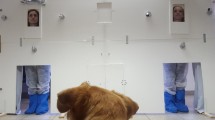Abstract
Dogs have a unique ability to understand visual cues from humans. We investigated whether dogs can discriminate between human facial expressions. Photographs of human faces were used to test nine pet dogs in two-choice discrimination tasks. The training phases involved each dog learning to discriminate between a set of photographs of their owner’s smiling and blank face. Of the nine dogs, five fulfilled these criteria and were selected for test sessions. In the test phase, 10 sets of photographs of the owner’s smiling and blank face, which had previously not been seen by the dog, were presented. The dogs selected the owner’s smiling face significantly more often than expected by chance. In subsequent tests, 10 sets of smiling and blank face photographs of 20 persons unfamiliar to the dogs were presented (10 males and 10 females). There was no statistical difference between the accuracy in the case of the owners and that in the case of unfamiliar persons with the same gender as the owner. However, the accuracy was significantly lower in the case of unfamiliar persons of the opposite gender to that of the owner, than with the owners themselves. These results suggest that dogs can learn to discriminate human smiling faces from blank faces by looking at photographs. Although it remains unclear whether dogs have human-like systems for visual processing of human facial expressions, the ability to learn to discriminate human facial expressions may have helped dogs adapt to human society.





Similar content being viewed by others
References
Abrantes R (1987) The expression of emotions in man and canid. J Small Anim Pract 28:1030–1036
Adachi I, Kuwahata H, Fujita K (2007) Dogs recall their owner’s face upon hearing the owner’s voice. Anim Cogn 10:17–21
Bradshaw JWS, Nott HMR (1995) Social and communication behaviour of companion dogs. The domestic dog: its evolution, behaviour and interactions with people. In: Serpell JA (ed) The domestic dog, its evolution, behavior and interactions with people, 11th edn. Cambridge University Press, Cambridge, pp 115–130
Call J, Brauer J, Kaminski J, Tomasello M (2003) Domestic dogs (Canis familiaris) are sensitive to the attentional state of humans. J Comp Psychol 117:257–263
Cellerino A, Borghetti D, Sartucci F (2004) Sex differences in face gender recognition in humans. Brain Res Bull 63:443–449
Ekman P, Friesen WV (1975) Unmasking the face: a guide to recognizing emotions from facial clues. Prentice-Hall Englewood Cliffs, NJ
Fox MW (1970) A comparative study of the development of facial expressions in canids; wolf, coyote and foxes. Behaviour 36:49–73
Gacsi M, Miklosi A, Varga O, Topal J, Csanyi V (2004) Are readers of our face readers of our minds? Dogs (Canis familiaris) show situation-dependent recognition of human’s attention. Anim Cogn 7:144–153
Guo K, Meints K, Hall C, Hall S, Mills D (2009) Left gaze bias in humans, rhesus monkeys and domestic dogs. Anim Cogn 12:409–418
Hare B, Call J, Tomasello M (1998) Communication of food location between human and dog (Canis familiaris). Evol Commun 2:137–159
Heffner H (1975) Perception of biologically meaningful sounds by dogs. J Acoust Soc Am 58:S124
Kanazawa S (1996) Recognition of facial expressions in a Japanese monkey (Macaca fuscata) and humans (Homo sapiens). Primates 37:25–38
Lore RK, Eisenberg FB (1986) Avoidance reactions of domestic dogs to unfamiliar male and female humans in a kennel setting. Appl Anim Behav Sci 15:261–266
Morisaki A, Takaoka A, Fujita K (2009) Are dogs sensitive to the emotional state of humans? J Vet Behav Clin Appl Res 4:49
Nagasawa M, Kikusui T, Onaka T, Ohta M (2009) Dog’s gaze at its owner increases owner’s urinary oxytocin during social interaction. Horm Behav 55:434–441
Racca A, Amadei E, Ligout S, Guo K, Meints K, Mills D (2010) Discrimination of human and dog faces and inversion responses in domestic dogs (Canis familiaris). Anim Cogn 13:525–533
Range F, Aust U, Steurer M, Huber L (2008) Visual categorization of natural stimuli by domestic dogs. Animal Cognit 11:339–347
Schwab C, Huber L (2006) Obey or not obey? Dogs (Canis familiaris) behave differently in response to attentional states of their owners. J Comp Psychol 120:169–175
Takaoka A, Morisaki A, Fujita K (2009) Intermodal representation in dogs. J Vet Behav Clin Appl Res 4:54–55
Udell MAR, Dorey NR, Wynne CDL (2010) What did domestication do to dogs? A new account of dogs’ sensitivity to human actions. Biol Rev 85:327–345
Vas J, Topál J, Gácsi M, Miklósi A, Csányi V (2005) A friend or an enemy? Dogs’ reaction to an unfamiliar person showing behavioural cues of threat and friendliness at different times. Appl Anim Behav Sci 94:99–115
Viranyi Z, Topál J, Gácsi M, Miklósi A, Csanyi V (2004) Dogs respond appropriately to cues of humans’ attentional focus. Behav Process 66:161–172
Wells DL (2003) Lateralised behaviour in the domestic dog, Canis familiaris. Behav Process 61:27–35
Wobber V, Hare B, Koler-Matznick J, Wrangham R, Tomasello M (2009) Breed differences in domestic dogs’ (Canis familiaris) comprehension of human communicative signals. Interact Stud 10:206–224
Author information
Authors and Affiliations
Corresponding author
Electronic supplementary material
Below is the link to the electronic supplementary material.
Test phase: Ten sets of photographs of the smiling face and blank face of the owner were presented (OW session). The photographs were changed once each trial. The smiling face photographs were the S+ (MPG 16397 kb)
Control phase: Photographs of the same smiling face of the owner were presented simultaneously (SS session). The S+ was chosen randomly once each trial (MPG 16197 kb)
Rights and permissions
About this article
Cite this article
Nagasawa, M., Murai, K., Mogi, K. et al. Dogs can discriminate human smiling faces from blank expressions. Anim Cogn 14, 525–533 (2011). https://doi.org/10.1007/s10071-011-0386-5
Received:
Revised:
Accepted:
Published:
Issue Date:
DOI: https://doi.org/10.1007/s10071-011-0386-5




